Antibody data
- Antibody Data
- Antigen structure
- References [81]
- Comments [0]
- Validations
- Immunocytochemistry [6]
- Immunohistochemistry [2]
- Other assay [26]
Submit
Validation data
Reference
Comment
Report error
- Product number
- MA3-913 - Provider product page

- Provider
- Invitrogen Antibodies
- Product name
- Calsequestrin Monoclonal Antibody (VIIID12)
- Antibody type
- Monoclonal
- Antigen
- Purifed from natural sources
- Description
- MA3-913 detects calsequestrin from human, mouse, rat, canine, porcine, chicken, and rabbit skeletal muscle tissues. This antibody recognizes calsequestrin in both type I (slow) and type II (fast) skeletal muscle tissues. MA3-913 has been successfully used in Western blot procedures. By Western blot, this antibody detects a 63 kDa protein representing calsequestrin from canine skeletal muscle extracts. Higher molecular weight proteins are seen on the Western blot and are believed to be calsequestrin-like proteins found in the sarcoplasmic reticulum. The staining pattern yields double rows of fluorescent dots corresponding to triad pairs on either side of the Z-line. The MA3-913 antigen is purified rabbit skeletal muscle sarcoplasmic reticulum.
- Reactivity
- Human, Mouse, Rat, Canine, Chicken/Avian, Porcine, Rabbit
- Host
- Mouse
- Isotype
- IgG
- Antibody clone number
- VIIID12
- Vial size
- 100 μL
- Concentration
- Conc. Not Determined
- Storage
- -20°C, Avoid Freeze/Thaw Cycles
Submitted references Loss of α-actinin-3 during human evolution provides superior cold resilience and muscle heat generation.
Neuromuscular junction instability and altered intracellular calcium handling as early determinants of force loss during unloading in humans.
Vitamin C and E Treatment Blunts Sprint Interval Training-Induced Changes in Inflammatory Mediator-, Calcium-, and Mitochondria-Related Signaling in Recreationally Active Elderly Humans.
Dietary nitrate supplementation increases diaphragm peak power in old mice.
Tissue-specific small heat shock protein 20 activation is not associated with traditional autophagy markers in Ossabaw swine with cardiometabolic heart failure.
Intracellular calcium leak lowers glucose storage in human muscle, promoting hyperglycemia and diabetes.
A chronic high-fat diet exacerbates contractile dysfunction with impaired intracellular Ca(2+) release capacity in the skeletal muscle of aged mice.
Sarcolipin Signaling Promotes Mitochondrial Biogenesis and Oxidative Metabolism in Skeletal Muscle.
Myostatin inhibition using mRK35 produces skeletal muscle growth and tubular aggregate formation in wild type and TgACTA1D286G nemaline myopathy mice.
Sarcolipin deletion exacerbates soleus muscle atrophy and weakness in phospholamban overexpressing mice.
Both brown adipose tissue and skeletal muscle thermogenesis processes are activated during mild to severe cold adaptation in mice.
Misregulation of calcium-handling proteins promotes hyperactivation of calcineurin-NFAT signaling in skeletal muscle of DM1 mice.
Identification and characterization of three novel mutations in the CASQ1 gene in four patients with tubular aggregate myopathy.
Long-term, but not short-term high-fat diet induces fiber composition changes and impaired contractile force in mouse fast-twitch skeletal muscle.
Increased Reliance on Muscle-based Thermogenesis upon Acute Minimization of Brown Adipose Tissue Function.
Caloric restriction induces energy-sparing alterations in skeletal muscle contraction, fiber composition and local thyroid hormone metabolism that persist during catch-up fat upon refeeding.
A mutation in the CASQ1 gene causes a vacuolar myopathy with accumulation of sarcoplasmic reticulum protein aggregates.
Observation of the molecular organization of calcium release sites in fast- and slow-twitch skeletal muscle with nanoscale imaging.
Distinct regions of triadin are required for targeting and retention at the junctional domain of the sarcoplasmic reticulum.
Myoplasmic resting Ca2+ regulation by ryanodine receptors is under the control of a novel Ca2+-binding region of the receptor.
The stress protein/chaperone Grp94 counteracts muscle disuse atrophy by stabilizing subsarcolemmal neuronal nitric oxide synthase.
Altered Ca2+ concentration, permeability and buffering in the myofibre Ca2+ store of a mouse model of malignant hyperthermia.
The anticancer drug tamoxifen counteracts the pathology in a mouse model of duchenne muscular dystrophy.
Application of fluorescence two-dimensional difference in-gel electrophoresis as a proteomic biomarker discovery tool in muscular dystrophy research.
Myotubularin and PtdIns3P remodel the sarcoplasmic reticulum in muscle in vivo.
Triadin/Junctin double null mouse reveals a differential role for Triadin and Junctin in anchoring CASQ to the jSR and regulating Ca(2+) homeostasis.
Abnormalities of calcium handling proteins in skeletal muscle mirror those of the heart in humans with heart failure: a shared mechanism?
Sarcolipin is a newly identified regulator of muscle-based thermogenesis in mammals.
Functional expression of transgenic 1sDHPR channels in adult mammalian skeletal muscle fibres.
DIGE analysis of rat skeletal muscle proteins using nonionic detergent phase extraction of young adult versus aged gastrocnemius tissue.
Proteomic profiling of naturally protected extraocular muscles from the dystrophin-deficient mdx mouse.
Caveolin 3 is associated with the calcium release complex and is modified via in vivo triadin modification.
Calcium-binding proteins in skeletal muscles of the mdx mice: potential role in the pathogenesis of Duchenne muscular dystrophy.
Ablation of skeletal muscle triadin impairs FKBP12/RyR1 channel interactions essential for maintaining resting cytoplasmic Ca2+.
Altered contractility of skeletal muscle in mice deficient in titin's M-band region.
T-tubule disorganization and defective excitation-contraction coupling in muscle fibers lacking myotubularin lipid phosphatase.
Sarcoplasmic-endoplasmic-reticulum Ca2+-ATPase and calsequestrin are overexpressed in spared intrinsic laryngeal muscles of dystrophin-deficient mdx mice.
Diltiazem and verapamil protect dystrophin-deficient muscle fibers of MDX mice from degeneration: a potential role in calcium buffering and sarcolemmal stability.
Triadin deletion induces impaired skeletal muscle function.
Reduced expression of sarcalumenin and related Ca2+ -regulatory proteins in aged rat skeletal muscle.
Conformation-dependent stability of junctophilin 1 (JP1) and ryanodine receptor type 1 (RyR1) channel complex is mediated by their hyper-reactive thiols.
Triadins modulate intracellular Ca(2+) homeostasis but are not essential for excitation-contraction coupling in skeletal muscle.
Microarray profiling of skeletal muscle sarcoplasmic reticulum proteins.
Identification of a novel phosphorylation site in protein phosphatase inhibitor-1 as a negative regulator of cardiac function.
Reduced expression of regucalcin in young and aged mdx diaphragm indicates abnormal cytosolic calcium handling in dystrophin-deficient muscle.
Differential expression of the fast skeletal muscle proteome following chronic low-frequency stimulation.
Expression of the skeletal muscle dystrophin-dystroglycan complex and syntrophin-nitric oxide synthase complex is severely affected in the type 2 diabetic Goto-Kakizaki rat.
Restricted distribution of mRNAs encoding a sarcoplasmic reticulum or transverse tubule protein in skeletal myofibers.
Triadins are not triad-specific proteins: two new skeletal muscle triadins possibly involved in the architecture of sarcoplasmic reticulum.
Transcriptional changes following restoration of SERCA2a levels in failing rat hearts.
Subproteomics analysis of Ca+-binding proteins demonstrates decreased calsequestrin expression in dystrophic mouse skeletal muscle.
Insights into cardioprotection obtained from study of cellular Ca2+ handling in myocardium of true hibernating mammals.
Increased sensitivity of the ryanodine receptor to halothane-induced oligomerization in malignant hyperthermia-susceptible human skeletal muscle.
Drastic reduction of sarcalumenin in Dp427 (dystrophin of 427 kDa)-deficient fibres indicates that abnormal calcium handling plays a key role in muscular dystrophy.
Comparative analysis of Dp427-deficient mdx tissues shows that the milder dystrophic phenotype of extraocular and toe muscle fibres is associated with a persistent expression of beta-dystroglycan.
Comparative analysis of Dp427-deficient mdx tissues shows that the milder dystrophic phenotype of extraocular and toe muscle fibres is associated with a persistent expression of beta-dystroglycan.
Increased expression of the nicotinic acetylcholine receptor in stimulated muscle.
Increased expression of the nicotinic acetylcholine receptor in stimulated muscle.
Use of continuous-elution gel electrophoresis as a preparative tool for blot overlay analysis.
Supramolecular calsequestrin complex.
Supramolecular calsequestrin complex.
Drastic reduction of calsequestrin-like proteins and impaired calcium binding in dystrophic mdx muscle.
The L-type calcium channel inhibitor diltiazem prevents cardiomyopathy in a mouse model.
Dynamic localization and clustering of dendritic Kv2.1 voltage-dependent potassium channels in developing hippocampal neurons.
Dynamic localization and clustering of dendritic Kv2.1 voltage-dependent potassium channels in developing hippocampal neurons.
Improvement in survival and cardiac metabolism after gene transfer of sarcoplasmic reticulum Ca(2+)-ATPase in a rat model of heart failure.
Improvement in survival and cardiac metabolism after gene transfer of sarcoplasmic reticulum Ca(2+)-ATPase in a rat model of heart failure.
Expression of endoplasmic reticulum stress proteins during skeletal muscle disuse atrophy.
Expression of endoplasmic reticulum stress proteins during skeletal muscle disuse atrophy.
Glucocorticoids increase sodium pump alpha(2)- and beta(1)-subunit abundance and mRNA in rat skeletal muscle.
Low-frequency stimulation of fast muscle affects the abundance of Ca(2+)-ATPase but not its oligomeric status.
Low-frequency stimulation of fast muscle affects the abundance of Ca(2+)-ATPase but not its oligomeric status.
Calsequestrin binds to monomeric and complexed forms of key calcium-handling proteins in native sarcoplasmic reticulum membranes from rabbit skeletal muscle.
Calsequestrin binds to monomeric and complexed forms of key calcium-handling proteins in native sarcoplasmic reticulum membranes from rabbit skeletal muscle.
Exogenous Ca2+-ATPase isoform effects on Ca2+ transients of embryonic chicken and neonatal rat cardiac myocytes.
A transgenic myogenic cell line lacking ryanodine receptor protein for homologous expression studies: reconstitution of Ry1R protein and function.
A transgenic myogenic cell line lacking ryanodine receptor protein for homologous expression studies: reconstitution of Ry1R protein and function.
Effects of aging on in vivo synthesis of skeletal muscle myosin heavy-chain and sarcoplasmic protein in humans.
Analysis of excitation-contraction-coupling components in chronically stimulated canine skeletal muscle.
Analysis of excitation-contraction-coupling components in chronically stimulated canine skeletal muscle.
Specific absence of the alpha 1 subunit of the dihydropyridine receptor in mice with muscular dysgenesis.
Wyckelsma VL, Venckunas T, Houweling PJ, Schlittler M, Lauschke VM, Tiong CF, Wood HD, Ivarsson N, Paulauskas H, Eimantas N, Andersson DC, North KN, Brazaitis M, Westerblad H
American journal of human genetics 2021 Mar 4;108(3):446-457
American journal of human genetics 2021 Mar 4;108(3):446-457
Neuromuscular junction instability and altered intracellular calcium handling as early determinants of force loss during unloading in humans.
Monti E, Reggiani C, Franchi MV, Toniolo L, Sandri M, Armani A, Zampieri S, Giacomello E, Sarto F, Sirago G, Murgia M, Nogara L, Marcucci L, Ciciliot S, Šimunic B, Pišot R, Narici MV
The Journal of physiology 2021 Jun;599(12):3037-3061
The Journal of physiology 2021 Jun;599(12):3037-3061
Vitamin C and E Treatment Blunts Sprint Interval Training-Induced Changes in Inflammatory Mediator-, Calcium-, and Mitochondria-Related Signaling in Recreationally Active Elderly Humans.
Wyckelsma VL, Venckunas T, Brazaitis M, Gastaldello S, Snieckus A, Eimantas N, Baranauskiene N, Subocius A, Skurvydas A, Pääsuke M, Gapeyeva H, Kaasik P, Pääsuke R, Jürimäe J, Graf BA, Kayser B, Place N, Andersson DC, Kamandulis S, Westerblad H
Antioxidants (Basel, Switzerland) 2020 Sep 17;9(9)
Antioxidants (Basel, Switzerland) 2020 Sep 17;9(9)
Dietary nitrate supplementation increases diaphragm peak power in old mice.
Kumar RA, Kelley RC, Hahn D, Ferreira LF
The Journal of physiology 2020 Oct;598(19):4357-4369
The Journal of physiology 2020 Oct;598(19):4357-4369
Tissue-specific small heat shock protein 20 activation is not associated with traditional autophagy markers in Ossabaw swine with cardiometabolic heart failure.
Silva KAS, Leary EV, Olver TD, Domeier TL, Padilla J, Rector RS, Emter CA
American journal of physiology. Heart and circulatory physiology 2020 Nov 1;319(5):H1036-H1043
American journal of physiology. Heart and circulatory physiology 2020 Nov 1;319(5):H1036-H1043
Intracellular calcium leak lowers glucose storage in human muscle, promoting hyperglycemia and diabetes.
Tammineni ER, Kraeva N, Figueroa L, Manno C, Ibarra CA, Klip A, Riazi S, Rios E
eLife 2020 May 4;9
eLife 2020 May 4;9
A chronic high-fat diet exacerbates contractile dysfunction with impaired intracellular Ca(2+) release capacity in the skeletal muscle of aged mice.
Eshima H, Tamura Y, Kakehi S, Kakigi R, Hashimoto R, Funai K, Kawamori R, Watada H
Journal of applied physiology (Bethesda, Md. : 1985) 2020 May 1;128(5):1153-1162
Journal of applied physiology (Bethesda, Md. : 1985) 2020 May 1;128(5):1153-1162
Sarcolipin Signaling Promotes Mitochondrial Biogenesis and Oxidative Metabolism in Skeletal Muscle.
Maurya SK, Herrera JL, Sahoo SK, Reis FCG, Vega RB, Kelly DP, Periasamy M
Cell reports 2018 Sep 11;24(11):2919-2931
Cell reports 2018 Sep 11;24(11):2919-2931
Myostatin inhibition using mRK35 produces skeletal muscle growth and tubular aggregate formation in wild type and TgACTA1D286G nemaline myopathy mice.
Tinklenberg JA, Siebers EM, Beatka MJ, Meng H, Yang L, Zhang Z, Ross JA, Ochala J, Morris C, Owens JM, Laing NG, Nowak KJ, Lawlor MW
Human molecular genetics 2018 Feb 15;27(4):638-648
Human molecular genetics 2018 Feb 15;27(4):638-648
Sarcolipin deletion exacerbates soleus muscle atrophy and weakness in phospholamban overexpressing mice.
Fajardo VA, Gamu D, Mitchell A, Bloemberg D, Bombardier E, Chambers PJ, Bellissimo C, Quadrilatero J, Tupling AR
PloS one 2017;12(3):e0173708
PloS one 2017;12(3):e0173708
Both brown adipose tissue and skeletal muscle thermogenesis processes are activated during mild to severe cold adaptation in mice.
Bal NC, Singh S, Reis FCG, Maurya SK, Pani S, Rowland LA, Periasamy M
The Journal of biological chemistry 2017 Oct 6;292(40):16616-16625
The Journal of biological chemistry 2017 Oct 6;292(40):16616-16625
Misregulation of calcium-handling proteins promotes hyperactivation of calcineurin-NFAT signaling in skeletal muscle of DM1 mice.
Ravel-Chapuis A, Bélanger G, Côté J, Michel RN, Jasmin BJ
Human molecular genetics 2017 Jun 15;26(12):2192-2206
Human molecular genetics 2017 Jun 15;26(12):2192-2206
Identification and characterization of three novel mutations in the CASQ1 gene in four patients with tubular aggregate myopathy.
Barone V, Del Re V, Gamberucci A, Polverino V, Galli L, Rossi D, Costanzi E, Toniolo L, Berti G, Malandrini A, Ricci G, Siciliano G, Vattemi G, Tomelleri G, Pierantozzi E, Spinozzi S, Volpi N, Fulceri R, Battistutta R, Reggiani C, Sorrentino V
Human mutation 2017 Dec;38(12):1761-1773
Human mutation 2017 Dec;38(12):1761-1773
Long-term, but not short-term high-fat diet induces fiber composition changes and impaired contractile force in mouse fast-twitch skeletal muscle.
Eshima H, Tamura Y, Kakehi S, Kurebayashi N, Murayama T, Nakamura K, Kakigi R, Okada T, Sakurai T, Kawamori R, Watada H
Physiological reports 2017 Apr;5(7)
Physiological reports 2017 Apr;5(7)
Increased Reliance on Muscle-based Thermogenesis upon Acute Minimization of Brown Adipose Tissue Function.
Bal NC, Maurya SK, Singh S, Wehrens XH, Periasamy M
The Journal of biological chemistry 2016 Aug 12;291(33):17247-57
The Journal of biological chemistry 2016 Aug 12;291(33):17247-57
Caloric restriction induces energy-sparing alterations in skeletal muscle contraction, fiber composition and local thyroid hormone metabolism that persist during catch-up fat upon refeeding.
De Andrade PB, Neff LA, Strosova MK, Arsenijevic D, Patthey-Vuadens O, Scapozza L, Montani JP, Ruegg UT, Dulloo AG, Dorchies OM
Frontiers in physiology 2015;6:254
Frontiers in physiology 2015;6:254
A mutation in the CASQ1 gene causes a vacuolar myopathy with accumulation of sarcoplasmic reticulum protein aggregates.
Rossi D, Vezzani B, Galli L, Paolini C, Toniolo L, Pierantozzi E, Spinozzi S, Barone V, Pegoraro E, Bello L, Cenacchi G, Vattemi G, Tomelleri G, Ricci G, Siciliano G, Protasi F, Reggiani C, Sorrentino V
Human mutation 2014 Oct;35(10):1163-70
Human mutation 2014 Oct;35(10):1163-70
Observation of the molecular organization of calcium release sites in fast- and slow-twitch skeletal muscle with nanoscale imaging.
Jayasinghe ID, Munro M, Baddeley D, Launikonis BS, Soeller C
Journal of the Royal Society, Interface 2014 Oct 6;11(99)
Journal of the Royal Society, Interface 2014 Oct 6;11(99)
Distinct regions of triadin are required for targeting and retention at the junctional domain of the sarcoplasmic reticulum.
Rossi D, Bencini C, Maritati M, Benini F, Lorenzini S, Pierantozzi E, Scarcella AM, Paolini C, Protasi F, Sorrentino V
The Biochemical journal 2014 Mar 1;458(2):407-17
The Biochemical journal 2014 Mar 1;458(2):407-17
Myoplasmic resting Ca2+ regulation by ryanodine receptors is under the control of a novel Ca2+-binding region of the receptor.
Chen Y, Xue S, Zou J, Lopez JR, Yang JJ, Perez CF
The Biochemical journal 2014 Jun 1;460(2):261-71
The Biochemical journal 2014 Jun 1;460(2):261-71
The stress protein/chaperone Grp94 counteracts muscle disuse atrophy by stabilizing subsarcolemmal neuronal nitric oxide synthase.
Vitadello M, Gherardini J, Gorza L
Antioxidants & redox signaling 2014 Jun 1;20(16):2479-96
Antioxidants & redox signaling 2014 Jun 1;20(16):2479-96
Altered Ca2+ concentration, permeability and buffering in the myofibre Ca2+ store of a mouse model of malignant hyperthermia.
Manno C, Figueroa L, Royer L, Pouvreau S, Lee CS, Volpe P, Nori A, Zhou J, Meissner G, Hamilton SL, Ríos E
The Journal of physiology 2013 Sep 15;591(18):4439-57
The Journal of physiology 2013 Sep 15;591(18):4439-57
The anticancer drug tamoxifen counteracts the pathology in a mouse model of duchenne muscular dystrophy.
Dorchies OM, Reutenauer-Patte J, Dahmane E, Ismail HM, Petermann O, Patthey- Vuadens O, Comyn SA, Gayi E, Piacenza T, Handa RJ, Décosterd LA, Ruegg UT
The American journal of pathology 2013 Feb;182(2):485-504
The American journal of pathology 2013 Feb;182(2):485-504
Application of fluorescence two-dimensional difference in-gel electrophoresis as a proteomic biomarker discovery tool in muscular dystrophy research.
Carberry S, Zweyer M, Swandulla D, Ohlendieck K
Biology 2013 Dec 2;2(4):1438-64
Biology 2013 Dec 2;2(4):1438-64
Myotubularin and PtdIns3P remodel the sarcoplasmic reticulum in muscle in vivo.
Amoasii L, Hnia K, Chicanne G, Brech A, Cowling BS, Müller MM, Schwab Y, Koebel P, Ferry A, Payrastre B, Laporte J
Journal of cell science 2013 Apr 15;126(Pt 8):1806-19
Journal of cell science 2013 Apr 15;126(Pt 8):1806-19
Triadin/Junctin double null mouse reveals a differential role for Triadin and Junctin in anchoring CASQ to the jSR and regulating Ca(2+) homeostasis.
Boncompagni S, Thomas M, Lopez JR, Allen PD, Yuan Q, Kranias EG, Franzini-Armstrong C, Perez CF
PloS one 2012;7(7):e39962
PloS one 2012;7(7):e39962
Abnormalities of calcium handling proteins in skeletal muscle mirror those of the heart in humans with heart failure: a shared mechanism?
Middlekauff HR, Vigna C, Verity MA, Fonarow GC, Horwich TB, Hamilton MA, Shieh P, Tupling AR
Journal of cardiac failure 2012 Sep;18(9):724-33
Journal of cardiac failure 2012 Sep;18(9):724-33
Sarcolipin is a newly identified regulator of muscle-based thermogenesis in mammals.
Bal NC, Maurya SK, Sopariwala DH, Sahoo SK, Gupta SC, Shaikh SA, Pant M, Rowland LA, Bombardier E, Goonasekera SA, Tupling AR, Molkentin JD, Periasamy M
Nature medicine 2012 Oct;18(10):1575-9
Nature medicine 2012 Oct;18(10):1575-9
Functional expression of transgenic 1sDHPR channels in adult mammalian skeletal muscle fibres.
DiFranco M, Tran P, Quiñonez M, Vergara JL
The Journal of physiology 2011 Mar 15;589(Pt 6):1421-42
The Journal of physiology 2011 Mar 15;589(Pt 6):1421-42
DIGE analysis of rat skeletal muscle proteins using nonionic detergent phase extraction of young adult versus aged gastrocnemius tissue.
Donoghue P, Staunton L, Mullen E, Manning G, Ohlendieck K
Journal of proteomics 2010 Jun 16;73(8):1441-53
Journal of proteomics 2010 Jun 16;73(8):1441-53
Proteomic profiling of naturally protected extraocular muscles from the dystrophin-deficient mdx mouse.
Lewis C, Ohlendieck K
Biochemical and biophysical research communications 2010 Jun 11;396(4):1024-9
Biochemical and biophysical research communications 2010 Jun 11;396(4):1024-9
Caveolin 3 is associated with the calcium release complex and is modified via in vivo triadin modification.
Vassilopoulos S, Oddoux S, Groh S, Cacheux M, Fauré J, Brocard J, Campbell KP, Marty I
Biochemistry 2010 Jul 27;49(29):6130-5
Biochemistry 2010 Jul 27;49(29):6130-5
Calcium-binding proteins in skeletal muscles of the mdx mice: potential role in the pathogenesis of Duchenne muscular dystrophy.
Pertille A, de Carvalho CL, Matsumura CY, Neto HS, Marques MJ
International journal of experimental pathology 2010 Feb;91(1):63-71
International journal of experimental pathology 2010 Feb;91(1):63-71
Ablation of skeletal muscle triadin impairs FKBP12/RyR1 channel interactions essential for maintaining resting cytoplasmic Ca2+.
Eltit JM, Feng W, Lopez JR, Padilla IT, Pessah IN, Molinski TF, Fruen BR, Allen PD, Perez CF
The Journal of biological chemistry 2010 Dec 3;285(49):38453-62
The Journal of biological chemistry 2010 Dec 3;285(49):38453-62
Altered contractility of skeletal muscle in mice deficient in titin's M-band region.
Ottenheijm CA, Hidalgo C, Rost K, Gotthardt M, Granzier H
Journal of molecular biology 2009 Oct 16;393(1):10-26
Journal of molecular biology 2009 Oct 16;393(1):10-26
T-tubule disorganization and defective excitation-contraction coupling in muscle fibers lacking myotubularin lipid phosphatase.
Al-Qusairi L, Weiss N, Toussaint A, Berbey C, Messaddeq N, Kretz C, Sanoudou D, Beggs AH, Allard B, Mandel JL, Laporte J, Jacquemond V, Buj-Bello A
Proceedings of the National Academy of Sciences of the United States of America 2009 Nov 3;106(44):18763-8
Proceedings of the National Academy of Sciences of the United States of America 2009 Nov 3;106(44):18763-8
Sarcoplasmic-endoplasmic-reticulum Ca2+-ATPase and calsequestrin are overexpressed in spared intrinsic laryngeal muscles of dystrophin-deficient mdx mice.
Ferretti R, Marques MJ, Pertille A, Santo Neto H
Muscle & nerve 2009 May;39(5):609-15
Muscle & nerve 2009 May;39(5):609-15
Diltiazem and verapamil protect dystrophin-deficient muscle fibers of MDX mice from degeneration: a potential role in calcium buffering and sarcolemmal stability.
Matsumura CY, Pertille A, Albuquerque TC, Santo Neto H, Marques MJ
Muscle & nerve 2009 Feb;39(2):167-76
Muscle & nerve 2009 Feb;39(2):167-76
Triadin deletion induces impaired skeletal muscle function.
Oddoux S, Brocard J, Schweitzer A, Szentesi P, Giannesini B, Brocard J, Fauré J, Pernet-Gallay K, Bendahan D, Lunardi J, Csernoch L, Marty I
The Journal of biological chemistry 2009 Dec 11;284(50):34918-29
The Journal of biological chemistry 2009 Dec 11;284(50):34918-29
Reduced expression of sarcalumenin and related Ca2+ -regulatory proteins in aged rat skeletal muscle.
O'Connell K, Gannon J, Doran P, Ohlendieck K
Experimental gerontology 2008 Oct;43(10):958-61
Experimental gerontology 2008 Oct;43(10):958-61
Conformation-dependent stability of junctophilin 1 (JP1) and ryanodine receptor type 1 (RyR1) channel complex is mediated by their hyper-reactive thiols.
Phimister AJ, Lango J, Lee EH, Ernst-Russell MA, Takeshima H, Ma J, Allen PD, Pessah IN
The Journal of biological chemistry 2007 Mar 23;282(12):8667-77
The Journal of biological chemistry 2007 Mar 23;282(12):8667-77
Triadins modulate intracellular Ca(2+) homeostasis but are not essential for excitation-contraction coupling in skeletal muscle.
Shen X, Franzini-Armstrong C, Lopez JR, Jones LR, Kobayashi YM, Wang Y, Kerrick WG, Caswell AH, Potter JD, Miller T, Allen PD, Perez CF
The Journal of biological chemistry 2007 Dec 28;282(52):37864-74
The Journal of biological chemistry 2007 Dec 28;282(52):37864-74
Microarray profiling of skeletal muscle sarcoplasmic reticulum proteins.
Schulz JS, Palmer N, Steckelberg J, Jones SJ, Zeece MG
Biochimica et biophysica acta 2006 Sep;1764(9):1429-35
Biochimica et biophysica acta 2006 Sep;1764(9):1429-35
Identification of a novel phosphorylation site in protein phosphatase inhibitor-1 as a negative regulator of cardiac function.
Rodriguez P, Mitton B, Waggoner JR, Kranias EG
The Journal of biological chemistry 2006 Dec 15;281(50):38599-608
The Journal of biological chemistry 2006 Dec 15;281(50):38599-608
Reduced expression of regucalcin in young and aged mdx diaphragm indicates abnormal cytosolic calcium handling in dystrophin-deficient muscle.
Doran P, Dowling P, Donoghue P, Buffini M, Ohlendieck K
Biochimica et biophysica acta 2006 Apr;1764(4):773-85
Biochimica et biophysica acta 2006 Apr;1764(4):773-85
Differential expression of the fast skeletal muscle proteome following chronic low-frequency stimulation.
Donoghue P, Doran P, Dowling P, Ohlendieck K
Biochimica et biophysica acta 2005 Sep 25;1752(2):166-76
Biochimica et biophysica acta 2005 Sep 25;1752(2):166-76
Expression of the skeletal muscle dystrophin-dystroglycan complex and syntrophin-nitric oxide synthase complex is severely affected in the type 2 diabetic Goto-Kakizaki rat.
Mulvey C, Harno E, Keenan A, Ohlendieck K
European journal of cell biology 2005 Nov;84(11):867-83
European journal of cell biology 2005 Nov;84(11):867-83
Restricted distribution of mRNAs encoding a sarcoplasmic reticulum or transverse tubule protein in skeletal myofibers.
Nissinen M, Kaisto T, Salmela P, Peltonen J, Metsikkö K
The journal of histochemistry and cytochemistry : official journal of the Histochemistry Society 2005 Feb;53(2):217-27
The journal of histochemistry and cytochemistry : official journal of the Histochemistry Society 2005 Feb;53(2):217-27
Triadins are not triad-specific proteins: two new skeletal muscle triadins possibly involved in the architecture of sarcoplasmic reticulum.
Vassilopoulos S, Thevenon D, Rezgui SS, Brocard J, Chapel A, Lacampagne A, Lunardi J, Dewaard M, Marty I
The Journal of biological chemistry 2005 Aug 5;280(31):28601-9
The Journal of biological chemistry 2005 Aug 5;280(31):28601-9
Transcriptional changes following restoration of SERCA2a levels in failing rat hearts.
Del Monte F, Dalal R, Tabchy A, Couget J, Bloch KD, Peterson R, Hajjar RJ
FASEB journal : official publication of the Federation of American Societies for Experimental Biology 2004 Sep;18(12):1474-6
FASEB journal : official publication of the Federation of American Societies for Experimental Biology 2004 Sep;18(12):1474-6
Subproteomics analysis of Ca+-binding proteins demonstrates decreased calsequestrin expression in dystrophic mouse skeletal muscle.
Doran P, Dowling P, Lohan J, McDonnell K, Poetsch S, Ohlendieck K
European journal of biochemistry 2004 Oct;271(19):3943-52
European journal of biochemistry 2004 Oct;271(19):3943-52
Insights into cardioprotection obtained from study of cellular Ca2+ handling in myocardium of true hibernating mammals.
Yatani A, Kim SJ, Kudej RK, Wang Q, Depre C, Irie K, Kranias EG, Vatner SF, Vatner DE
American journal of physiology. Heart and circulatory physiology 2004 Jun;286(6):H2219-28
American journal of physiology. Heart and circulatory physiology 2004 Jun;286(6):H2219-28
Increased sensitivity of the ryanodine receptor to halothane-induced oligomerization in malignant hyperthermia-susceptible human skeletal muscle.
Glover L, Heffron JJ, Ohlendieck K
Journal of applied physiology (Bethesda, Md. : 1985) 2004 Jan;96(1):11-8
Journal of applied physiology (Bethesda, Md. : 1985) 2004 Jan;96(1):11-8
Drastic reduction of sarcalumenin in Dp427 (dystrophin of 427 kDa)-deficient fibres indicates that abnormal calcium handling plays a key role in muscular dystrophy.
Dowling P, Doran P, Ohlendieck K
The Biochemical journal 2004 Apr 15;379(Pt 2):479-88
The Biochemical journal 2004 Apr 15;379(Pt 2):479-88
Comparative analysis of Dp427-deficient mdx tissues shows that the milder dystrophic phenotype of extraocular and toe muscle fibres is associated with a persistent expression of beta-dystroglycan.
Dowling P, Lohan J, Ohlendieck K
European journal of cell biology 2003 May;82(5):222-30
European journal of cell biology 2003 May;82(5):222-30
Comparative analysis of Dp427-deficient mdx tissues shows that the milder dystrophic phenotype of extraocular and toe muscle fibres is associated with a persistent expression of beta-dystroglycan.
Dowling P, Lohan J, Ohlendieck K
European journal of cell biology 2003 May;82(5):222-30
European journal of cell biology 2003 May;82(5):222-30
Increased expression of the nicotinic acetylcholine receptor in stimulated muscle.
O'Reilly C, Pette D, Ohlendieck K
Biochemical and biophysical research communications 2003 Jan 10;300(2):585-91
Biochemical and biophysical research communications 2003 Jan 10;300(2):585-91
Increased expression of the nicotinic acetylcholine receptor in stimulated muscle.
O'Reilly C, Pette D, Ohlendieck K
Biochemical and biophysical research communications 2003 Jan 10;300(2):585-91
Biochemical and biophysical research communications 2003 Jan 10;300(2):585-91
Use of continuous-elution gel electrophoresis as a preparative tool for blot overlay analysis.
Mulvey C, Ohlendieck K
Analytical biochemistry 2003 Aug 1;319(1):122-30
Analytical biochemistry 2003 Aug 1;319(1):122-30
Supramolecular calsequestrin complex.
Glover L, Quinn S, Ryan M, Pette D, Ohlendieck K
European journal of biochemistry 2002 Sep;269(18):4607-16
European journal of biochemistry 2002 Sep;269(18):4607-16
Supramolecular calsequestrin complex.
Glover L, Quinn S, Ryan M, Pette D, Ohlendieck K
European journal of biochemistry 2002 Sep;269(18):4607-16
European journal of biochemistry 2002 Sep;269(18):4607-16
Drastic reduction of calsequestrin-like proteins and impaired calcium binding in dystrophic mdx muscle.
Culligan K, Banville N, Dowling P, Ohlendieck K
Journal of applied physiology (Bethesda, Md. : 1985) 2002 Feb;92(2):435-45
Journal of applied physiology (Bethesda, Md. : 1985) 2002 Feb;92(2):435-45
The L-type calcium channel inhibitor diltiazem prevents cardiomyopathy in a mouse model.
Semsarian C, Ahmad I, Giewat M, Georgakopoulos D, Schmitt JP, McConnell BK, Reiken S, Mende U, Marks AR, Kass DA, Seidman CE, Seidman JG
The Journal of clinical investigation 2002 Apr;109(8):1013-20
The Journal of clinical investigation 2002 Apr;109(8):1013-20
Dynamic localization and clustering of dendritic Kv2.1 voltage-dependent potassium channels in developing hippocampal neurons.
Antonucci DE, Lim ST, Vassanelli S, Trimmer JS
Neuroscience 2001;108(1):69-81
Neuroscience 2001;108(1):69-81
Dynamic localization and clustering of dendritic Kv2.1 voltage-dependent potassium channels in developing hippocampal neurons.
Antonucci DE, Lim ST, Vassanelli S, Trimmer JS
Neuroscience 2001;108(1):69-81
Neuroscience 2001;108(1):69-81
Improvement in survival and cardiac metabolism after gene transfer of sarcoplasmic reticulum Ca(2+)-ATPase in a rat model of heart failure.
del Monte F, Williams E, Lebeche D, Schmidt U, Rosenzweig A, Gwathmey JK, Lewandowski ED, Hajjar RJ
Circulation 2001 Sep 18;104(12):1424-9
Circulation 2001 Sep 18;104(12):1424-9
Improvement in survival and cardiac metabolism after gene transfer of sarcoplasmic reticulum Ca(2+)-ATPase in a rat model of heart failure.
del Monte F, Williams E, Lebeche D, Schmidt U, Rosenzweig A, Gwathmey JK, Lewandowski ED, Hajjar RJ
Circulation 2001 Sep 18;104(12):1424-9
Circulation 2001 Sep 18;104(12):1424-9
Expression of endoplasmic reticulum stress proteins during skeletal muscle disuse atrophy.
Hunter RB, Mitchell-Felton H, Essig DA, Kandarian SC
American journal of physiology. Cell physiology 2001 Oct;281(4):C1285-90
American journal of physiology. Cell physiology 2001 Oct;281(4):C1285-90
Expression of endoplasmic reticulum stress proteins during skeletal muscle disuse atrophy.
Hunter RB, Mitchell-Felton H, Essig DA, Kandarian SC
American journal of physiology. Cell physiology 2001 Oct;281(4):C1285-90
American journal of physiology. Cell physiology 2001 Oct;281(4):C1285-90
Glucocorticoids increase sodium pump alpha(2)- and beta(1)-subunit abundance and mRNA in rat skeletal muscle.
Thompson CB, Dorup I, Ahn J, Leong PK, McDonough AA
American journal of physiology. Cell physiology 2001 Mar;280(3):C509-16
American journal of physiology. Cell physiology 2001 Mar;280(3):C509-16
Low-frequency stimulation of fast muscle affects the abundance of Ca(2+)-ATPase but not its oligomeric status.
Harmon S, Froemming GR, Leisner E, Pette D, Ohlendieck K
Journal of applied physiology (Bethesda, Md. : 1985) 2001 Jan;90(1):371-9
Journal of applied physiology (Bethesda, Md. : 1985) 2001 Jan;90(1):371-9
Low-frequency stimulation of fast muscle affects the abundance of Ca(2+)-ATPase but not its oligomeric status.
Harmon S, Froemming GR, Leisner E, Pette D, Ohlendieck K
Journal of applied physiology (Bethesda, Md. : 1985) 2001 Jan;90(1):371-9
Journal of applied physiology (Bethesda, Md. : 1985) 2001 Jan;90(1):371-9
Calsequestrin binds to monomeric and complexed forms of key calcium-handling proteins in native sarcoplasmic reticulum membranes from rabbit skeletal muscle.
Glover L, Culligan K, Cala S, Mulvey C, Ohlendieck K
Biochimica et biophysica acta 2001 Dec 1;1515(2):120-32
Biochimica et biophysica acta 2001 Dec 1;1515(2):120-32
Calsequestrin binds to monomeric and complexed forms of key calcium-handling proteins in native sarcoplasmic reticulum membranes from rabbit skeletal muscle.
Glover L, Culligan K, Cala S, Mulvey C, Ohlendieck K
Biochimica et biophysica acta 2001 Dec 1;1515(2):120-32
Biochimica et biophysica acta 2001 Dec 1;1515(2):120-32
Exogenous Ca2+-ATPase isoform effects on Ca2+ transients of embryonic chicken and neonatal rat cardiac myocytes.
Cavagna M, O'Donnell JM, Sumbilla C, Inesi G, Klein MG
The Journal of physiology 2000 Oct 1;528 Pt 1(Pt 1):53-63
The Journal of physiology 2000 Oct 1;528 Pt 1(Pt 1):53-63
A transgenic myogenic cell line lacking ryanodine receptor protein for homologous expression studies: reconstitution of Ry1R protein and function.
Moore RA, Nguyen H, Galceran J, Pessah IN, Allen PD
The Journal of cell biology 1998 Feb 23;140(4):843-51
The Journal of cell biology 1998 Feb 23;140(4):843-51
A transgenic myogenic cell line lacking ryanodine receptor protein for homologous expression studies: reconstitution of Ry1R protein and function.
Moore RA, Nguyen H, Galceran J, Pessah IN, Allen PD
The Journal of cell biology 1998 Feb 23;140(4):843-51
The Journal of cell biology 1998 Feb 23;140(4):843-51
Effects of aging on in vivo synthesis of skeletal muscle myosin heavy-chain and sarcoplasmic protein in humans.
Balagopal P, Rooyackers OE, Adey DB, Ades PA, Nair KS
The American journal of physiology 1997 Oct;273(4):E790-800
The American journal of physiology 1997 Oct;273(4):E790-800
Analysis of excitation-contraction-coupling components in chronically stimulated canine skeletal muscle.
Ohlendieck K, Briggs FN, Lee KF, Wechsler AW, Campbell KP
European journal of biochemistry 1991 Dec 18;202(3):739-47
European journal of biochemistry 1991 Dec 18;202(3):739-47
Analysis of excitation-contraction-coupling components in chronically stimulated canine skeletal muscle.
Ohlendieck K, Briggs FN, Lee KF, Wechsler AW, Campbell KP
European journal of biochemistry 1991 Dec 18;202(3):739-47
European journal of biochemistry 1991 Dec 18;202(3):739-47
Specific absence of the alpha 1 subunit of the dihydropyridine receptor in mice with muscular dysgenesis.
Knudson CM, Chaudhari N, Sharp AH, Powell JA, Beam KG, Campbell KP
The Journal of biological chemistry 1989 Jan 25;264(3):1345-8
The Journal of biological chemistry 1989 Jan 25;264(3):1345-8
No comments: Submit comment
Supportive validation
- Submitted by
- Invitrogen Antibodies (provider)
- Main image
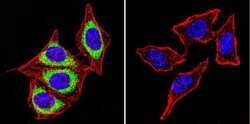
- Experimental details
- Immunofluorescent analysis of Calsequestrin using Anti-Calsequestrin Monoclonal Antibody (VIIID12) (Product # MA3-913) shows staining in Hela Cells. Calsequestrin staining (green), F-Actin staining with Phalloidin (red) and nuclei with DAPI (blue) is shown. Cells were grown on chamber slides and fixed with formaldehyde prior to staining. Cells were probed without (control) or with or an antibody recognizing Calsequestrin (Product # MA3-913) at a dilution of 1:100 over night at 4°C, washed with PBS and incubated with a DyLight-488 conjugated secondary antibody (Product # 35503, Goat Anti-Mouse). Images were taken at 60X magnification.
- Submitted by
- Invitrogen Antibodies (provider)
- Main image
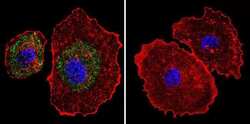
- Experimental details
- Immunofluorescent analysis of Calsequestrin using Anti-Calsequestrin Monoclonal Antibody (VIIID12) (Product # MA3-913) shows staining in MCF-7 Cells. Calsequestrin staining (green), F-Actin staining with Phalloidin (red) and nuclei with DAPI (blue) is shown. Cells were grown on chamber slides and fixed with formaldehyde prior to staining. Cells were probed without (control) or with or an antibody recognizing Calsequestrin (Product # MA3-913) at a dilution of 1:100 over night at 4°C, washed with PBS and incubated with a DyLight-488 conjugated secondary antibody (Product # 35503, Goat Anti-Mouse). Images were taken at 60X magnification.
- Submitted by
- Invitrogen Antibodies (provider)
- Main image
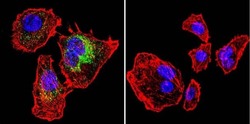
- Experimental details
- Immunofluorescent analysis of Calsequestrin using Anti-Calsequestrin Monoclonal Antibody (VIIID12) (Product # MA3-913) shows staining in U251 Cells. Calsequestrin staining (green), F-Actin staining with Phalloidin (red) and nuclei with DAPI (blue) is shown. Cells were grown on chamber slides and fixed with formaldehyde prior to staining. Cells were probed without (control) or with or an antibody recognizing Calsequestrin (Product # MA3-913) at a dilution of 1:100 over night at 4°C, washed with PBS and incubated with a DyLight-488 conjugated secondary antibody (Product # 35503, Goat Anti-Mouse). Images were taken at 60X magnification.
- Submitted by
- Invitrogen Antibodies (provider)
- Main image
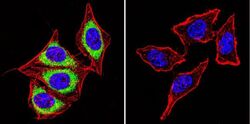
- Experimental details
- Immunofluorescent analysis of Calsequestrin using Anti-Calsequestrin Monoclonal Antibody (VIIID12) (Product # MA3-913) shows staining in Hela Cells. Calsequestrin staining (green), F-Actin staining with Phalloidin (red) and nuclei with DAPI (blue) is shown. Cells were grown on chamber slides and fixed with formaldehyde prior to staining. Cells were probed without (control) or with or an antibody recognizing Calsequestrin (Product # MA3-913) at a dilution of 1:100 over night at 4°C, washed with PBS and incubated with a DyLight-488 conjugated secondary antibody (Product # 35503, Goat Anti-Mouse). Images were taken at 60X magnification.
- Submitted by
- Invitrogen Antibodies (provider)
- Main image
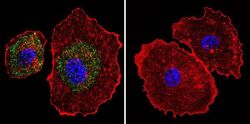
- Experimental details
- Immunofluorescent analysis of Calsequestrin using Anti-Calsequestrin Monoclonal Antibody (VIIID12) (Product # MA3-913) shows staining in MCF-7 Cells. Calsequestrin staining (green), F-Actin staining with Phalloidin (red) and nuclei with DAPI (blue) is shown. Cells were grown on chamber slides and fixed with formaldehyde prior to staining. Cells were probed without (control) or with or an antibody recognizing Calsequestrin (Product # MA3-913) at a dilution of 1:100 over night at 4°C, washed with PBS and incubated with a DyLight-488 conjugated secondary antibody (Product # 35503, Goat Anti-Mouse). Images were taken at 60X magnification.
- Submitted by
- Invitrogen Antibodies (provider)
- Main image
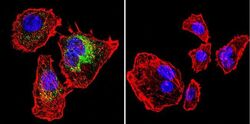
- Experimental details
- Immunofluorescent analysis of Calsequestrin using Anti-Calsequestrin Monoclonal Antibody (VIIID12) (Product # MA3-913) shows staining in U251 Cells. Calsequestrin staining (green), F-Actin staining with Phalloidin (red) and nuclei with DAPI (blue) is shown. Cells were grown on chamber slides and fixed with formaldehyde prior to staining. Cells were probed without (control) or with or an antibody recognizing Calsequestrin (Product # MA3-913) at a dilution of 1:100 over night at 4°C, washed with PBS and incubated with a DyLight-488 conjugated secondary antibody (Product # 35503, Goat Anti-Mouse). Images were taken at 60X magnification.
Supportive validation
- Submitted by
- Invitrogen Antibodies (provider)
- Main image
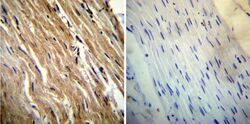
- Experimental details
- Immunohistochemistry was performed on normal deparaffinized Human heart tissue tissues. To expose target proteins, heat induced antigen retrieval was performed using 10mM sodium citrate (pH6.0) buffer, microwaved for 8-15 minutes. Following antigen retrieval tissues were blocked in 3% BSA-PBS for 30 minutes at room temperature. Tissues were then probed at a dilution of 1:200 with a mouse monoclonal antibody recognizing Calsequestrin (Product # MA3-913) or without primary antibody (negative control) overnight at 4°C in a humidified chamber. Tissues were washed extensively with PBST and endogenous peroxidase activity was quenched with a peroxidase suppressor. Detection was performed using a biotin-conjugated secondary antibody and SA-HRP, followed by colorimetric detection using DAB. Tissues were counterstained with hematoxylin and prepped for mounting.
- Submitted by
- Invitrogen Antibodies (provider)
- Main image
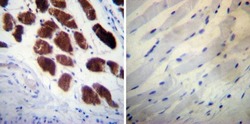
- Experimental details
- Immunohistochemistry was performed on normal deparaffinized Human skeletal muscle tissues. To expose target proteins, heat induced antigen retrieval was performed using 10mM sodium citrate (pH6.0) buffer, microwaved for 8-15 minutes. Following antigen retrieval tissues were blocked in 3% BSA-PBS for 30 minutes at room temperature. Tissues were then probed at a dilution of 1:20 with a mouse monoclonal antibody recognizing Calsequestrin (Product # MA3-913) or without primary antibody (negative control) overnight at 4°C in a humidified chamber. Tissues were washed extensively with PBST and endogenous peroxidase activity was quenched with a peroxidase suppressor. Detection was performed using a biotin-conjugated secondary antibody and SA-HRP, followed by colorimetric detection using DAB. Tissues were counterstained with hematoxylin and prepped for mounting.
Supportive validation
- Submitted by
- Invitrogen Antibodies (provider)
- Main image
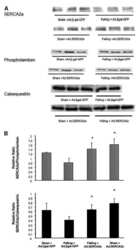
- Experimental details
- NULL
- Submitted by
- Invitrogen Antibodies (provider)
- Main image
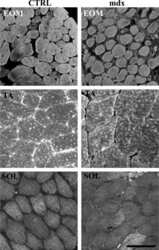
- Experimental details
- NULL
- Submitted by
- Invitrogen Antibodies (provider)
- Main image
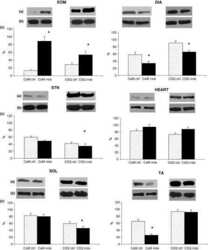
- Experimental details
- NULL
- Submitted by
- Invitrogen Antibodies (provider)
- Main image
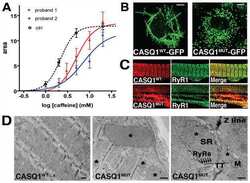
- Experimental details
- NULL
- Submitted by
- Invitrogen Antibodies (provider)
- Main image
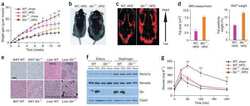
- Experimental details
- NULL
- Submitted by
- Invitrogen Antibodies (provider)
- Main image
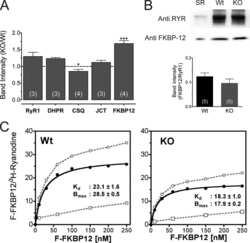
- Experimental details
- NULL
- Submitted by
- Invitrogen Antibodies (provider)
- Main image
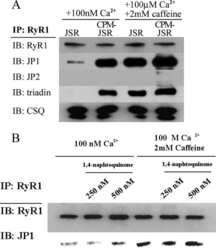
- Experimental details
- NULL
- Submitted by
- Invitrogen Antibodies (provider)
- Main image
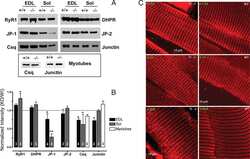
- Experimental details
- NULL
- Submitted by
- Invitrogen Antibodies (provider)
- Main image

- Experimental details
- NULL
- Submitted by
- Invitrogen Antibodies (provider)
- Main image
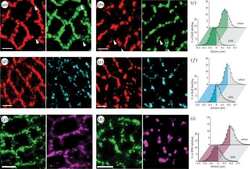
- Experimental details
- NULL
- Submitted by
- Invitrogen Antibodies (provider)
- Main image
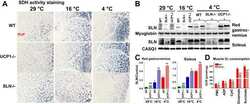
- Experimental details
- NULL
- Submitted by
- Invitrogen Antibodies (provider)
- Main image
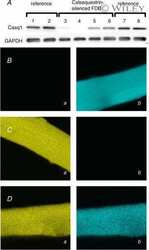
- Experimental details
- NULL
- Submitted by
- Invitrogen Antibodies (provider)
- Main image
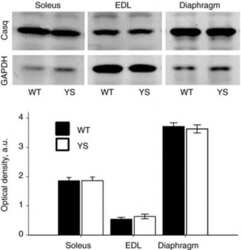
- Experimental details
- NULL
- Submitted by
- Invitrogen Antibodies (provider)
- Main image
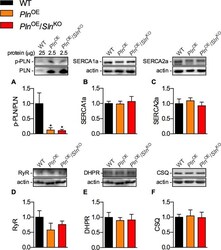
- Experimental details
- Fig 2 PLN phosphorylation and expression levels of other Ca 2+ regulatory proteins. (A) Western blot analyses demonstrating that monomeric p-PLN/PLN ratio is significantly lower in both Pln OE and Pln OE / Sln KO soleus muscles compared with WT (n = 5-6 per genotype). Western blotting for other major Ca 2+ regulatory proteins SERCA1a (B, 110 kDa), SERCA2a (C, 110 kDa), RyR (D, 565 kDa), DHPR (E, 170 kDa), and CSQ (F, 63 kDa) did not reveal any significant differences across genotypes (n = 5-8 per genotype, with a 6 mug load for all proteins). *Significantly different from WT using a a one-way ANOVA with a Tukey's post-hoc, p
- Submitted by
- Invitrogen Antibodies (provider)
- Main image
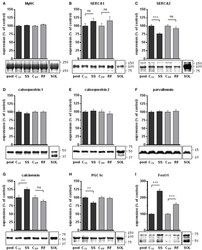
- Experimental details
- Figure 3 Expression levels of selected proteins in gastrocnemius extracts from semistarved and refed rats and their respective controls were determined by Western blots . (A) Amount of myosin heavy chains (MyHC) were determined by Coomassie staining in 3 independents experiments. MyHC were similarly abundant in all 4 groups and were thus validated as internal controls for the quantification of the other muscle markers under study. Selected proteins that are well known markers of Ca 2+ handling in slow-twitch or fast-twitch fibers were analyzed: (B) SERCA1, (C) SERCA2, (D) calsequestrin 1, (E) calsequestrin 2, and (F) parvalbumin. The abundance of transcription factors that control the development of slow-twitch muscles either positively or negatively were also determined: (G) calcineurin, (H) PGC1-alpha (the most intense band at the expected size for the full-length protein was analyzed; the smaller molecular weight bands likely to be degradation products were excluded), and (I) FoxO1 (all bands, likely representing native, methylated, and acetylated forms, were quantified). The signals (B-I) were corrected for their MyHC content and normalized to the signal of a pool sample (a mixture of aliquots of all extracts) loaded on the gels for the purpose of intra-gel and inter-gel comparison. The signals from an extract of soleus muscle (a slow-twitch muscle), referred to as SOL, are shown for comparison. They were acquired under the same exposure condition as the experimental grou
- Submitted by
- Invitrogen Antibodies (provider)
- Main image
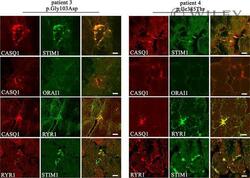
- Experimental details
- Immunofluorescence experiments on cross sections of biopsies from patients 3 and 4 revealed that nearly all tubular aggregates contained CASQ1. The vast majority of CASQ1 positive tubular aggregates were also positive for STIM1 and RYR1, whereas ORAI1 was rarely detected and at much lower extent in CASQ1 positive aggregates. Bars: 20 mum
- Submitted by
- Invitrogen Antibodies (provider)
- Main image
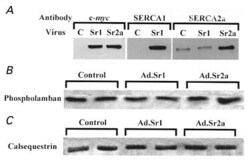
- Experimental details
- 2 Protein expression in embryonic chicken cardiac myocytes Embryonic chicken cardiac myocytes were infected with Ad.Sr1 (expressing SERCA1 ) or Ad.Sr2a (expressing SERCA2a ), and cell lysates were probed with various monoclonal antibodies. A , right, antibody to the c-myc tag found only in exogenous SERCA1 and SERCA2a; middle, antibody to SERCA1; left, antibody to endogenous and exogenous SERCA2a. Lane headings: C, control; Sr1, Ad.Sr1 infected; Sr2a, Ad.Sr2a infected. B , antibody to phospholamban. C , antibody to calsequestrin. For B and C , each lane was run in duplicate.
- Submitted by
- Invitrogen Antibodies (provider)
- Main image
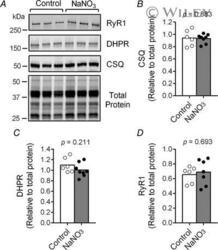
- Experimental details
- 5 Figure Abundance of key calcium-release proteins in the diaphragm does not change with NaNO 3 supplementation in old mice A , representative membrane immunoblot (top) and total protein gel (bottom) images. Quantification of immunoblot signal normalized to total protein for calsequestrin (CSQ) ( B ), DHPR (Ca v 1.1) ( C ), and ryanodine receptor 1 (RyR1) ( D ). Bars represent mean value and symbols are individual data from n = 6 (control) and 7-8 (NaNO 3 ) mice per group. P values are from unpaired Student's t tests.
- Submitted by
- Invitrogen Antibodies (provider)
- Main image
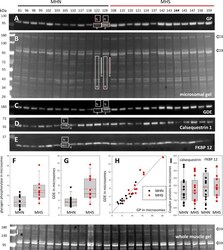
- Experimental details
- Figure 2. Protein content in patients' microsomes. ( A ) Western blot analysis of glycogen phosphorylase (GP) for 25 subjects, in a luminescence scale with black as 0 and white as saturating value. The numbers above each lane are patient identifiers that apply to all 25-lane gels shown in the article. The twelve lanes under the black bar have protein from MHN patients; those under the red bar are from MHS patients, except #144, which was reclassified as MHN. ( B ) Ponceau-stained gel that originated all blots in the figure. A and B illustrate our custom quantitative analysis. The content of every protein quantified in blots was calculated as the signal mass within region a above background (average level in b). Content was normalized for quantity of preparation in the lane dividing by the signal similarly calculated in the gel in B. The signal in B is computed in a large area of the lane to average multiple proteins in the fraction. The method is fully demonstrated in Video 1 . Arrows in B mark two bands, near 100 and 180 kDa, with a visibly greater signal in the MHS group. Their main components were GP and glycogen debranching enzyme (GDE) respectively. ( C-E ) Western blots of GDE, calsequestrin 1 and FKBP12 in different sections of gel B (identified by molecular weight markers at left). ( F and G ) Box plots of GP and GDE content. In both cases the content was greater on average for MHS and the differences significant (data in Table 1 ). ( H ) GP vs. GDE in blots A and C;
- Submitted by
- Invitrogen Antibodies (provider)
- Main image
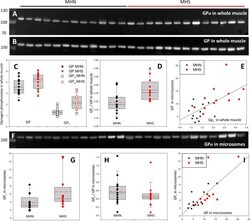
- Experimental details
- Figure 3. Phosphorylation of glycogen phosphorylase. ( A, B ) Western blots of 13 MHN and 12 MHS whole tissue lysates, identified in Figure 2 . Blots were derived from different gels loaded with aliquots of the same preparations. Originating gels for this blot and others are in Figure 3--figure supplement 1 . ( C ) The distribution of band signals in blots A and B. Statistical measures are listed in Table 1 . GP ( all-forms ) and GP a were higher in the MHS (p=0.07 for GP and 3 10 -4 for GP a ). ( D ) The median content ratio GP a /GP was 42% higher in the MHS (p = 0.005). ( E ) Cross-plot demonstrating correlation between GP a content in whole muscle and GP in microsomes ( r = 0.64, p = 5 10 -4 ). ( F ) Western blot of GP a in the microsomal fractions studied in Figure 2 . ( G, H ) Distributions of GP a in blot F and of the content ratio GP a /GP (the all-forms GP content was determined with blot A of Figure 2 ). GP a was higher by 71% (p = 0.05) but the phosphorylation ratio did not change significantly in the microsomal fraction (p = 0.28). ( I ) GP a vs. GP in microsomes. The correlation is high and highly significant ( r = 0.72, p < 10 -4 .). Figure 3--figure supplement 1. Protein gels for blots. ( A, B ) Ponceau-stained whole tissue extract gels used to derive Western blots of PhK, GPa and GDE ( A ) and all-forms GP ( B ). C-F. Ponceau-stained microsomal extract gels used to derive Western blots of GS ( C ), GSa ( D ), GDE ( E ) and GLUT4 and Casq1 ( F ). The signal in
- Submitted by
- Invitrogen Antibodies (provider)
- Main image
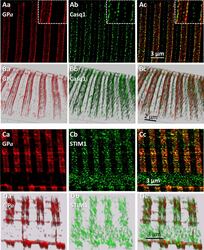
- Experimental details
- Figure 5. Phosphorylated glycogen phosphorylase, GP a , localizes at SR. ( A ) Sections of a z -stack (corrected as in Figure 4 ) of human muscle co-stained for GP a and Casq1(I.D. #164, MHN). ( B ) 3-D renderings of the z -stacks that contained the sections in A. Both proteins delineate two terminal cisternae, TC, in every triad. The inset in Ac shows close proximity of the imaged proteins, without actual colocalization (documented with Figure 5--figure supplement 1 ). ( C, D ) Sections and stack from a human myofiber co-stained for GP a and STIM1 (I.D. #164, MHN). GP a delineates two TC in every triad (Ca, Da). STIM1 forms clusters in close proximity to the GP a bands, without actual colocalization. Minor quantities of both proteins are located outside triads. A large quantity of STIM1, unaccompanied by GP a , appears inside a nucleus (cf. (). These images are the first to resolve TC with conventional optics (a resolution of ~100 nm is estimated with Figure 5--figure supplement 2 ). Figure 5--figure supplement 1. Analysis of colocalization of GP a and STIM1. ( A ) Enlarged part of text Figure 5 panel Cc. ( B ) Object-based analysis, by JACoP, of images in panels Ca (GP a ) and Cb (STIM1) of Figure 5 . Centers of signal mass of STIM1 'objects' (i.e. automatically detected connected areas of fluorescence) are marked by a green symbol. Centers of objects in the GP a image are marked in red. Green and red locations are different but close. ( C ) Van Steensel's approach to calcu
- Submitted by
- Invitrogen Antibodies (provider)
- Main image
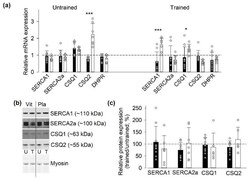
- Experimental details
- Figure 4 Limited SIT-induced changes in mRNA and protein expression of other SR Ca 2+ -handling proteins than RyR1. ( a ) Mean and individual data of the ratio of mRNA expression 1 h after to that before the first (Untrained) and last (Trained) SIT sessions in individuals treated with vitamins ( n = 9) or with placebo ( n = 7); dashed line indicates no difference between before and after exercise. Two-way repeated measures ANOVA showed a general group difference ( p < 0.01) in the untrained state. Difference between vitamins and placebo groups in relative mRNA expression of individual genes: * p < 0.05, *** p < 0.001. ( b ) Representative original Western blots from one individual treated with vitamins (Vit) and one treated with placebo (Pla). Biopsies taken before the first (untrained, U) and the last (trained, T) SIT session. Lower panels show stain-free loading controls. ( c ) Mean and individual data of the relative protein expression in biopsies obtained in the untrained and the trained state in individuals treated with vitamins (n = 10) or with placebo ( n = 6-7). Data expressed as the ratio of the expression in the trained to that in the untrained state; dashed line indicate no difference between the two states. No significant differences between the untrained and the trained state or between vitamin and placebo-treated individuals were observed with two-way repeated measures ANOVA. Data are shown as mean +- SD; vitamin group, black bars; placebo group, white bars.
- Submitted by
- Invitrogen Antibodies (provider)
- Main image
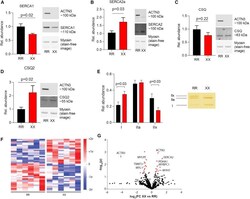
- Experimental details
- Figure 2 ACTN3 deficiency is accompanied by a shift toward a slower skeletal muscle phenotype (A-D) Summary data (mean +- SEM) and representative western blots of the SR Ca 2+ -handling proteins SERCA1, SERCA2a, CSQ, and CSQ2 in muscle of RR (n = 8) and XX (n = 7) individuals. Band intensities were normalized to their respective myosin loading controls. Data expressed relative to the mean value of the RR group, which was set to 1.0. Statistical difference between the two groups was assessed with unpaired t test. (E) Silver-stained gels were used to assess the distribution of MyHC isoforms in RR (n = 7) and XX (n = 7) individuals. Right part shows a representative example of the distribution of MyHC in RR and XX individuals. The total staining of the three MyHC bands was set to 1 in each subject. Statistical difference between the two groups was tested with unpaired t test. (F) Mean-centered sigma-normalized heatmap of differentially expressed proteins (p < 0.05). (G) Volcano plot of all identified proteins (n = 601) expressed as fold-change (FC) in XX compared to RR individuals. Differentially abundant proteins are indicated in red.
- Submitted by
- Invitrogen Antibodies (provider)
- Main image
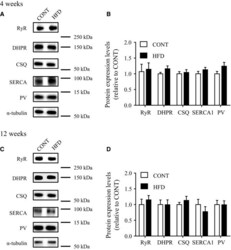
- Experimental details
- Figure 5 Expression levels of muscle calcium-regulated proteins in mice after a high-fat diet. Protein levels in control mice ( CONT ) and high-fat diet-fed mice ( HFD ; upper panel: 4 weeks; lower panels: 12 weeks). Left: representative western blots of RyR, DHPR , CSQ , SERCA 1 and PV proteins (A: 4 weeks; C: 12 weeks). A protein expression levels expressed relative to the value of CONT mice (B: 4 weeks; D: 12 weeks). Values are means +- SE ( n = 7).
- Submitted by
- Invitrogen Antibodies (provider)
- Main image
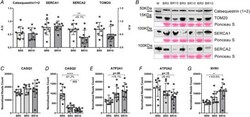
- Experimental details
- Figure 7 Variations of gene and protein expression involved in Ca 2+ handling in response to 10-day bed rest Calsequestrin1-2, SERCA1, SERCA2 and TOM20 amount in muscle homogenates as obtained by western blot at baseline (BR0) and after 10 days of bed rest (BR10) ( A ). Representative western blot of CASQ1-2, SERCA1, SERCA2 and TOM20 ( B ). CASQ1 and CASQ2 gene expression (encoding for Calsequestrin1 and Calsequestrin2, respectively) ( C , D ), ATP2A1 and ATP2A2 gene expression (encoding for SERCA1 and SERCA2, respectively) ( E , F ); RYR1 gene expression (encoding for Ryanodine Receptor 1) ( G ). All RNA transcripts are reported as normalized read count at BR0, after 5 days of bed rest (BR5) and at BR10. Results shown as means +- SD, individual data represented as scatter plots. * P < 0.05 BR10 vs BR0, ** P < 0.01 BR10 vs BR0, **** P < 0.0001 BR10 vs BR0.
- Submitted by
- Invitrogen Antibodies (provider)
- Main image
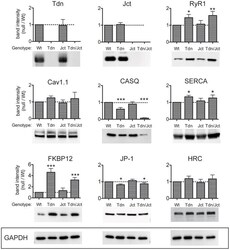
- Experimental details
- Figure 1 Relative levels of CRU proteins in crude homogenates from skeletal muscle. Identical amounts (25 ug/lane) of microsomal fraction of skeletal muscles from WT, Tdn-, Jct- and Tdn-/Jct mice were loaded and immunoblotted with several antibodies. Membranes were tested for expression of triadin (Tdn), junctin (Jct), ryanodine receptor (RyR1), Dihydropyridine receptors (Cav1.1), Calsequestrin (CASQ), SERCA-1 pump (SERCA), FK506 binding protein (FKBP12), Junctophilin-1 (JP-1) and Histidin-rich Ca 2+ binding protein (HRC) as described in Material and Methods. Band intensity for each protein was normalized to GAPDH expression to correct for loading and plotted as fraction of its WT counterpart (dotted line). Data presented as mean +- SD of 3-7 independent blots. * p
 Explore
Explore Validate
Validate Learn
Learn Western blot
Western blot Immunocytochemistry
Immunocytochemistry